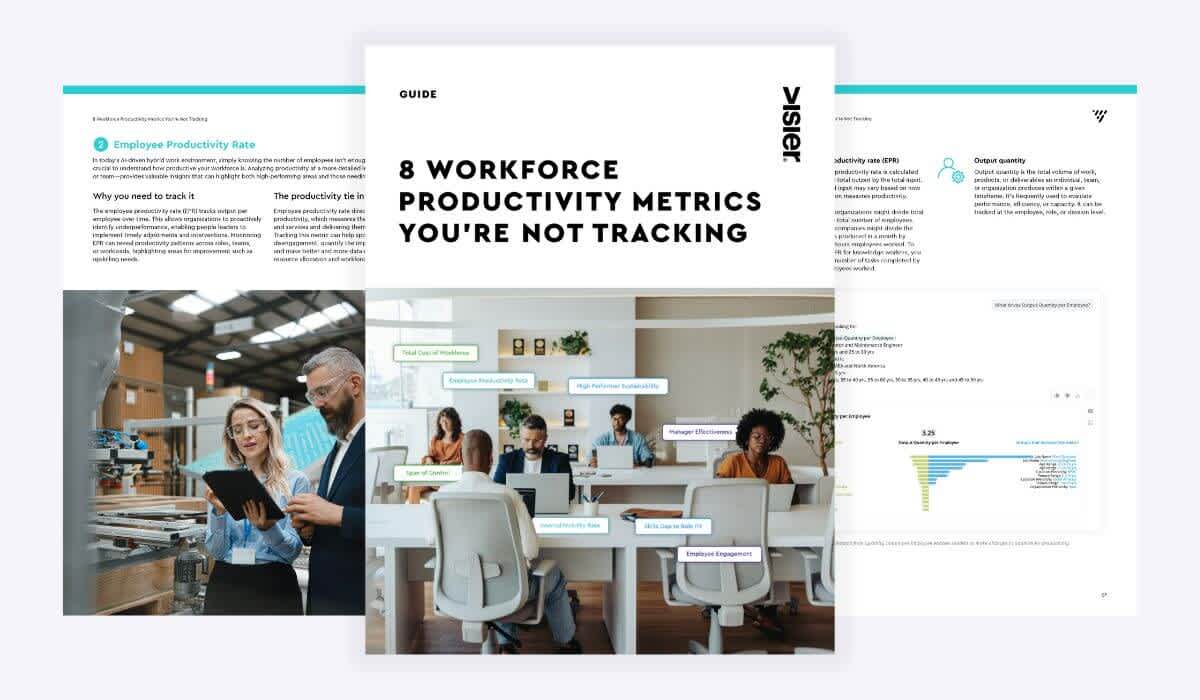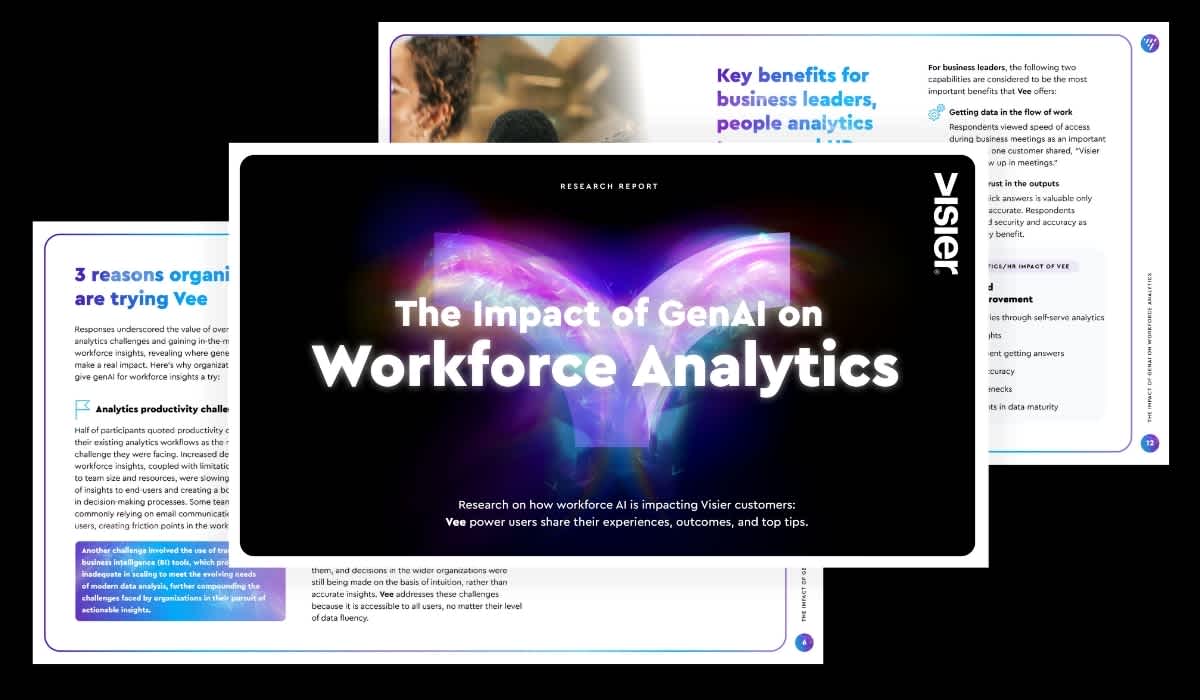Workforce Optimization in the AI Era: Key Benefits, Strategies, and Examples
Workforce optimization can boost productivity, engagement, and cut costs. Discover key strategies and the power of AI-driven insights. Read more.

Workforce optimization is an important planning strategy, especially to cut costs, boost productivity, and enhance employee engagement. You’re probably already doing it to some extent whenever you train your team or distribute work among full-time equivalent (FTE) employees and contractors, for example. To maximize the impact, understanding which tools and data to leverage is key.
In this article, you’ll learn:
What is workforce optimization?
What is the difference between workforce management and workforce optimization?
Benefits of workforce optimization
How to set clear workforce optimization goals
Key strategies for workforce optimization
Measuring the impact of workforce optimization
What is workforce optimization?
Workforce optimization is a process or series of steps you outline to improve your team’s performance by relying on clear data and technology.
Workforce optimization was designed to lower labor costs and minimize overstaffing or overtime. Beyond budget, it’s a great strategy for those who want to better optimize schedules and workloads without the guesswork.
This also means you’ll always have the data and processes to act quickly and respond to shifts of demand in an economy or market increasingly characterized by seasonal peaks.
Scalability is key, but that’s what also defines workforce management. So what are the differences between the two?

What is the difference between workforce management and workforce optimization?
Workforce management focuses on operations like scheduling, time tracking, and keeping your workforce compliant.
Workforce optimization takes a holistic view of your people and their work. For starters, it actually brings over workforce management through analytics, performance management, and engagement.
But while workforce management alone is mostly about executing the process of getting work done, workforce optimization is all about improving execution to get better results, stay competitive, and keep your team sharp.
Benefits of workforce optimization
Beyond simply streamlining operations, workforce optimization significantly impacts employee engagement, customer satisfaction, and overall financial health. This strategy leads to increased workforce productivity and a competitive edge. Let's explore how these benefits in-depth.
Workforce optimization increases workforce productivity and competitiveness
Gallup calls companies that are constantly tweaking their workforce best-practice organizations. Their research reveals that over 70% of employees within these best-practice organizations are more engaged and get a competitive edge. The same study also analyzes how engagement has been receding compared to previous years.
That’s exactly why organizations rely on workforce optimization to improve employee skills, schedules, and tasks. Using data-driven insights lets you identify performance and create tailored training for an efficient allocation of talented resources.
According to Gallup, companies that consistently refine their workforce see over 70% of employees more engaged and get a competitive edge.
Workforce optimization improves customer experience and loyalty
Companies with engaged employees see a 10% increase in customer loyalty and a 23% boost in profitability.
Having enough staff means timely service, high-quality service, and better customer satisfaction. Engaged employees who are well supported are much more likely to create positive interactions, which builds trust with customers.
Predictive analytics can help anticipate demand, allowing for proactive engagement from your team before the customer reaches out about a specific problem or service. The costs for this aren’t as high as you’d think, either.
Workforce optimization to reduce costs
Efficient scheduling alone decreases excess labor, reduces overtime, and minimizes labor expense. Process improvements and automation can eliminate operational redundancy and inefficiencies (plus the overhead costs associated with them). You can get all of these benefits with a simple tweak.
Gore Mutual Insurance Co., Canada's oldest property and casualty insurer, was dealing with challenges associated with an HR data process that was heavily manual and too spreadsheet-reliant. This was holding them back from ambitious growth plans.
After adopting Visier's people analytics platform, they were able to proactively manage risks, ultimately keeping their team members longer and improving the employee experience.
They used Visier's predictive analytics to identify their turnover risk in key teams, map employee journeys to enhance employee experience, and give management and stakeholders real-time insights into data.
With Visier, they were able to easily access the necessary insights to make better operational and strategic business decisions, reduce turnover, enhance employee experience, and drive operational efficiency and growth.

How to set clear workforce optimization goals
Stick to this three-step process framework for workforce optimization to see results early.
1. Align goals with overall business objectives
Start by making a list of your actionable goals for workforce optimization. These should focus on how you can correct inefficiencies, increase productivity, and improve employee engagement. Then, prioritize them based on their impact on your overarching business goals.
A mid-sized call center, for instance, might experience high turnover rates that reflect poor customer service because of missed calls and customer dissatisfaction.
Your goals in this case would be to improve employee retention and customer satisfaction.
To keep these goals aligned, though, you��’ll need to run an internal audit to find out why employee turnover is happening in the first place. This will help you see if the problems are culture-based, process-based, or similar.
On the customer’s side, pull from your customer experience data to get a 360-degree view of how customers feel and uncover internal root causes of external issues.
2. Defining measurable KPIs
Key performance indicators are essential metrics that can clarify which areas need performance adjustments. The general rule of thumb is to keep them SMART (specific, measurable, achievable, relevant, and time-bound).
You have plenty of options here. The call center team could track progress using KPIs like turnover rate, customer satisfaction score, or schedule adherence.
3. Setting realistic timelines
Timelines (you can also rely just on deadlines) keep your team focused and often come with smaller goals or targets to make sure your project isn’t stalling. Here’s an example of a timeline for the same call center example:
Months 1-2: Roll out new scheduling software and train managers on using it.
Months 3-5: Implement flexible schedules and provide first training sessions for agents.
Months 6-12: Monitor KPIs monthly, adjust training as per CSAT responses, and monitor the turnover trends.
Key strategies for workforce optimization
With clear goals in place, it’s time for action.
1. Skills gap analysis and training
A skills gap analysis compares your team’s current capabilities with the skills required to meet the organizational goals above. Once you’ve spotted a gap, it’s your turn to plan out training and workshops to support employees in developing their skills.
Employee surveys or performance evaluations help you score their skill gaps against the requirements of the job. Use Visier to monitor metrics such as task completion rates or even the quality of your training programs.
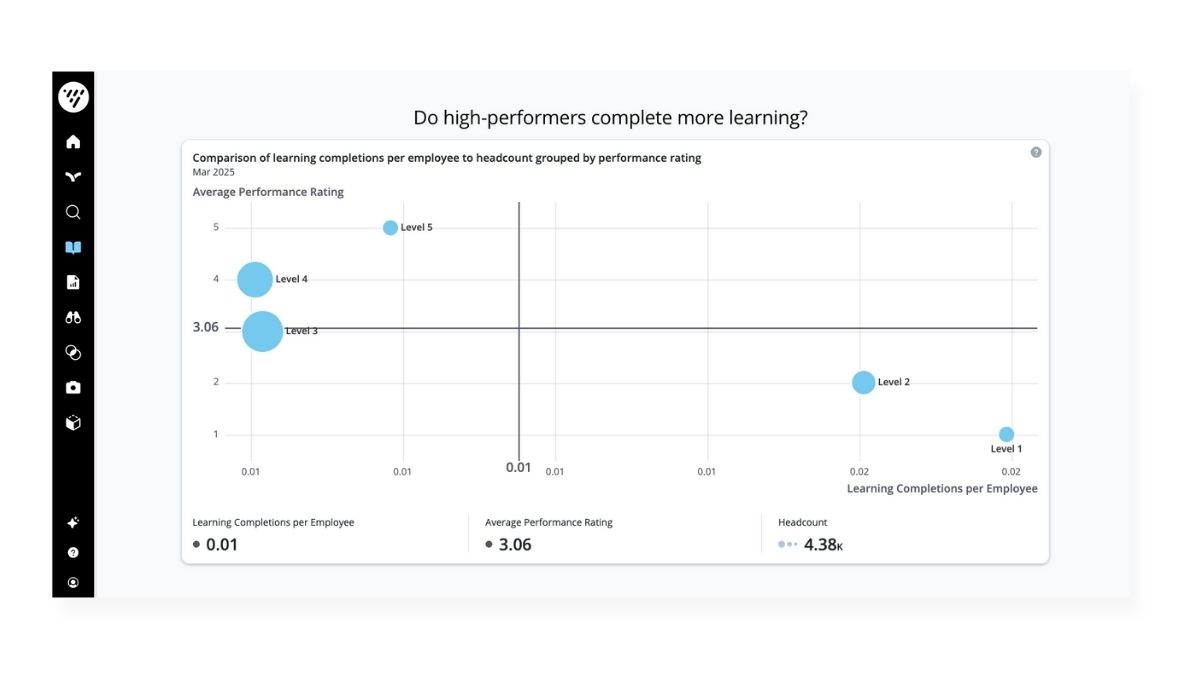
2. Workflow automation and process improvement
Optimize your workforce by automating repetitive tasks and redesigning inefficient workflows. Identify repetitive tasks suitable for automation, such as payroll processing and user provisioning, and leverage AI tools and agents to make them more efficient.
Providing HR teams, executives, and people managers with direct access to self-serve workforce analytics improves workload for the people analytics team by handling simple requests and puts insights in the hands of the end user to make strategic decisions faster. With Visier’s AI digital assistant, Vee, you can get instant people insights by asking questions in natural language and getting instant answers to them:
Improve workforce optimization by automating routine tasks and streamlining inefficient processes. Pinpoint repetitive tasks ripe for automation, such as payroll processing and user provisioning, and enhance their efficiency using AI tools and agents.
Empowering HR teams, executives, and people managers with self-serve analytics reduces the workload of the people analytics team by reducing basic inquiries in their queue, and enables end-users to gain quicker insights for more informed strategic decisions. Visier’s AI digital assistant, Vee, allows any user to instantly obtain people insights by asking natural language questions and receiving immediate responses.
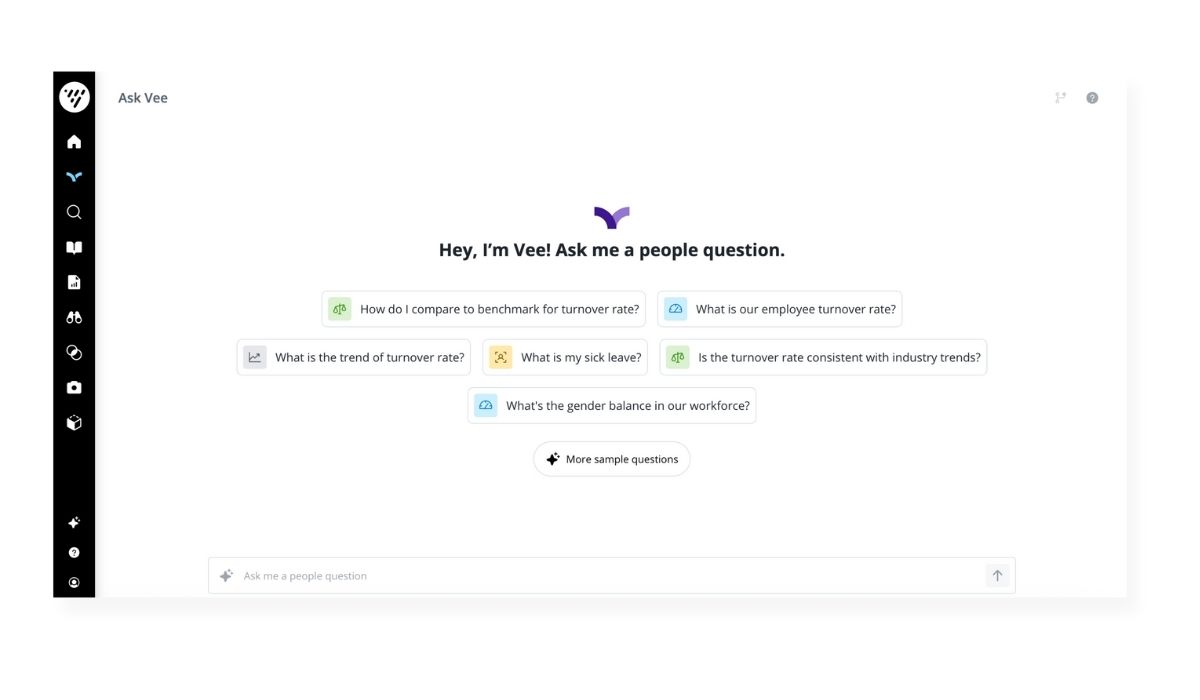
3. Strategic workforce planning
Predictive analytics and workforce planning tools help anticipate staffing demands and build robust talent pipelines.
Use Visier’s workforce planning and budgeting solutions for business forecasts to estimate staffing capacity. This will help you improve recruitment or upskilling strategies, such as deciding when it’s best to work with training providers or keep it all in-house, and measure metrics to track whether your planning efforts are successful.
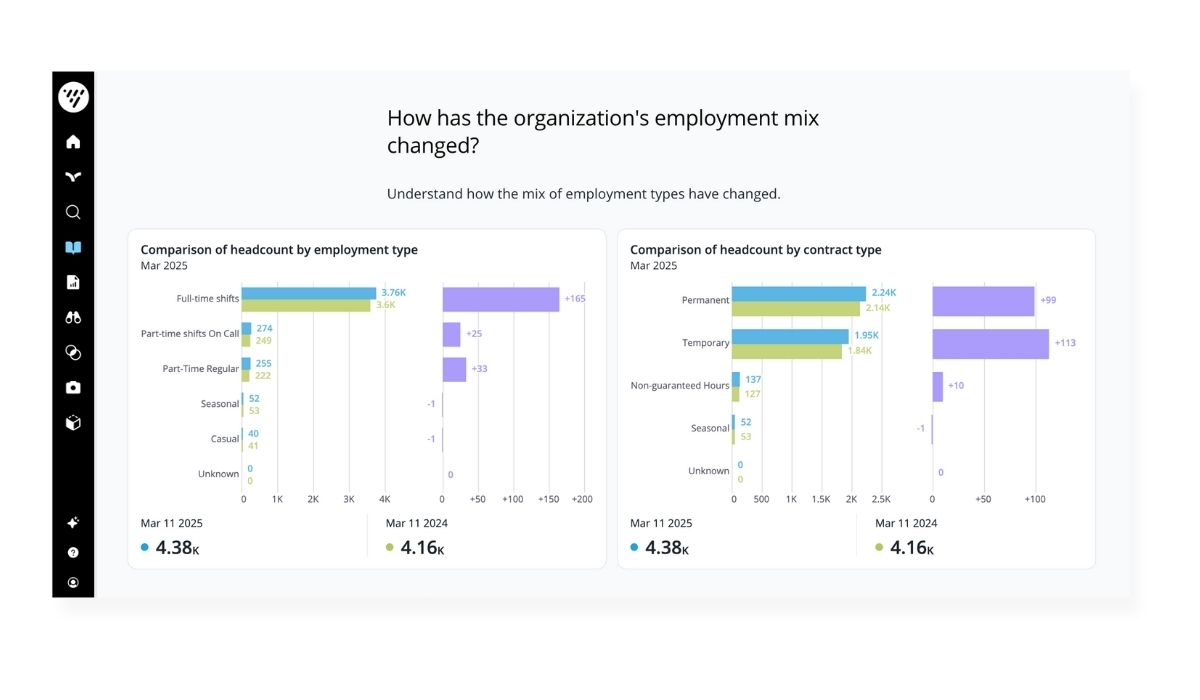
Measuring the impact of workforce optimization
With these workforce optimization strategies in place, let’s take a moment to review their impact.
1. Use analytics to understand your workforce and its results
Workforce analytics platforms unite and analyze your data anywhere you have it. By bringing these insights into one solution, you get a clear view of employee types and trends. This lets you find pain points in the managerial processes and quantitatively measure the effect of workforce optimization on productivity and business outcomes.
Auto Club Group (ACG) used Visier to understand its workforce dynamics and took action to mitigate turnover in customer-facing and operational roles. With Visier analytics as a single source of truth, ACG could finally see its turnover rates and all the elements that led to understanding it (such as average tenure and average performance ratings across its workforce).
ACG was also able to understand which roles were critical for service delivery and operational flow. This made it possible for the team to address potential talent risks before they disrupted service or operations.
As a result, the organization achieved a significant decrease in turnover within these crucial positions. This directly contributed to greater consistency in service delivery, reduced operational delays, and improved team productivity in vital business areas.

2. Track KPIs, ROI, and other business metrics
Understanding how people and teams work to achieve goals is essential for managing and scaling positive business outcomes. By connecting employee data (e.g., skills, engagement, and turnover) with operational work data (like task completion, service quality, and efficiency), you gain a comprehensive view of workforce productivity—its volume, speed, and quality in relation to compensation. This integrated approach gives you a better contextual understanding of where your team stands against their progress to support smarter decision-making.
3. Identify areas for further optimization
Analytics and workforce optimization tools help you keep an eye on real-time performance and detect problems as soon as they happen.
Conversely, they also give you the chance to identify areas of greatest opportunity and try out new approaches in parts of the organization. This lets you test and repeat, measuring the impact of a new process change before you scale it at a wider organizational level.
For instance, Auto Club Group was able to predict future talent needs with Visier People® Talent Acquisition. The tool had them re-analyze their internal recruitment pipeline and helped them see how long it took to backfill roles.
This allowed them to start the recruitment process well before a vacancy opened to ensure continuity in filling critical positions.
Where to go next?
If your people data and work data live on different platforms, it’s time to bring them together into a single analytics platform. This will give you more flexibility and prevent data loss or the annoying back-and-forth between different platforms.
It also means you’ll have a solid foundation to try workforce analytics and bring data from all of your sources, enabling predictive workforce planning.
Take a 5-minute, self-guided tour to see how Visier will help you navigate challenging business environments and even exceed your financial targets.


